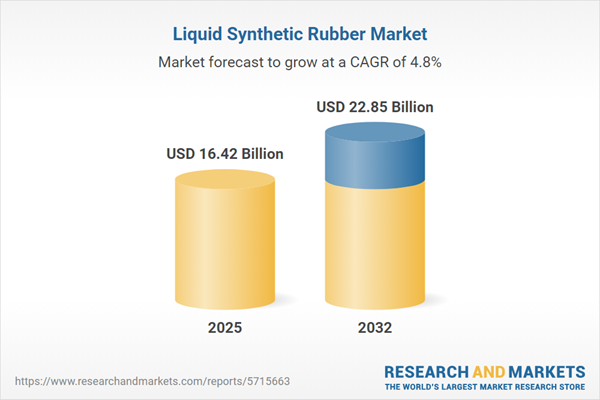Speak directly to the analyst to clarify any post sales queries you may have.
Liquid synthetic rubber offers manufacturers a highly adaptable solution for optimizing efficiency, supporting regulatory compliance, and advancing sustainable supply chain practices in today’s evolving industrial landscape. Its versatility empowers senior decision-makers to address complex production and sourcing challenges with confidence.
Market Snapshot: Liquid Synthetic Rubber Market Size and Growth
The liquid synthetic rubber market attained a global valuation of USD 15.70 billion in 2024, forecast to reach USD 16.42 billion in 2025, and projected at USD 22.85 billion by 2032. This reflects a CAGR of 4.80%. Multiple industries—including manufacturing, construction, packaging, and automotive—are accelerating their integration of liquid synthetic rubber as they prioritize advanced material solutions. As end-user sectors face heightened pressure for improved material performance and operational efficiency, liquid synthetic rubber is influencing shifts in production workflows and procurement models. Increasing capital allocation to cutting-edge materials ensures organizations can adapt to compliance demands, support sustainability initiatives, and strengthen their competitive positions amidst changing global standards.
Scope & Segmentation: Core Drivers in the Liquid Synthetic Rubber Market
- Material Types: Butadiene rubber, isoprene rubber, and nitrile rubber each provide robust mechanical strength, extensive resistance to chemicals, and application flexibility—making them well-suited for industries where durability is critical and performance requirements are varied.
- Application Areas: The market covers adhesives, sealants, paints, coatings, rubber compounding, asphalt modification, and tire manufacturing. In these segments, liquid synthetic rubber extends product lifespan, elevates process efficiency, and supports a wide range of functional goals.
- End-User Sectors: Automotive (including both electric vehicles and internal combustion engines), aviation, construction, packaging, textiles, and sports equipment manufacturers increasingly utilize liquid synthetic rubber to adapt to rapid technology changes and shifting regulatory landscapes.
- Sales Channels: Organizations benefit from flexible procurement structures, including both online and offline sourcing, to optimize their logistics networks and remain aligned with regulatory variations impacting global trade.
- Geographic Reach: Key market activity spans the Americas, Europe, Middle East and Africa, and Asia-Pacific, with notable manufacturing and supply chain hubs in China, India, Japan, Australia, South Korea, and the United States supporting regional and international operations.
- Key Industry Players: Leading contributors such as Apcotex Industries Limited, Dow Chemical Company, DuPont de Nemours Inc., Synthomer PLC, Trelleborg Group, Wacker Chemie AG, Evonik Industries AG, and JSR Corporation are consistently developing innovative solutions in response to evolving procurement needs and forward-looking material technologies.
Key Takeaways: Strategic Insights for Senior Decision-Makers
- Ongoing investment in advanced polymerization and catalyst technologies is enabling manufacturers to strategically enhance operational flexibility and recalibrate supply chain efficiencies to meet international quality benchmarks.
- Greater adoption of sustainable methods—such as the use of renewable feedstocks and solvent-free manufacturing—supports enhanced environmental compliance and signals an intensified focus on responsible corporate practices.
- Liquid synthetic rubber empowers the production of lightweight, high-strength components, stimulating innovation in sectors committed to achieving higher energy efficiency and stringent technical parameters.
- Digital transformation initiatives are optimizing manufacturing processes, allowing for improved quality assurance, predictive maintenance informed by data analytics, and more agile operations that bolster supply chain resilience.
- Efforts to encourage local sourcing and targeted research and development activities are strengthening supply security, reducing vulnerability to disruptions, and supporting overall business continuity for global organizations.
Tariff Impact: Navigating United States Trade Developments
With new United States tariffs expected in 2025, organizations are reevaluating supply chain models and focusing on domestic sourcing approaches. This shift aims to minimize risk from changes in trade policy, ensure operational continuity, and reinforce comprehensive compliance and risk management frameworks to navigate evolving trade requirements effectively.
Methodology & Data Sources
Our analysis incorporates direct interviews with key industry leaders and systematic examination of global trade patterns. Data is aggregated using advanced intelligence platforms to provide relevant, actionable insights tailored to executive decision-making and strategic planning within the liquid synthetic rubber sector.
Why This Report Matters: Value for Senior Leadership
- Delivers targeted intelligence to inform executive strategies for successful market entry and expansion within the liquid synthetic rubber segment.
- Enables comprehensive assessment of evolving supply networks, technology trends, and policy adaptations, equipping organizations to proactively manage upcoming regulatory and market shifts.
- Helps leadership prioritize operational and technological innovation, fostering business resilience and securing a solid, sustainable competitive edge.
Conclusion
This report guides senior leaders with data-driven analysis to enhance procurement processes, increase operational agility, and support informed responses to the changing liquid synthetic rubber market environment.
Additional Product Information:
- Purchase of this report includes 1 year online access with quarterly updates.
- This report can be updated on request. Please contact our Customer Experience team using the Ask a Question widget on our website.
Table of Contents
3. Executive Summary
4. Market Overview
7. Cumulative Impact of Artificial Intelligence 2025
Companies Mentioned
The companies profiled in this Liquid Synthetic Rubber market report include:- Apcotex Industries Limited
- Avantor, Inc.
- CHT Group
- Dow Chemical Company
- DuPont de Nemours, Inc.
- Elkem ASA
- Evonik Industries AG
- Firestone Polymers, LLC
- JSR Corporation
- Kraton Corporation
- Kuraray Co., Ltd.
- LG Chem Ltd.
- Lion Elastomers, LLC
- Momentive Performance Materials Inc.
- Nippon Zeon Co., Ltd.
- Shanghai Fuyou International Trade Co., Ltd.
- Shanghai Theorem Chemical Technology Co., Ltd.
- Synthomer PLC
- Trelleborg Group
- Wacker Chemie AG
- Zeon Chemicals L.P.
Table Information
| Report Attribute | Details |
|---|---|
| No. of Pages | 186 |
| Published | November 2025 |
| Forecast Period | 2025 - 2032 |
| Estimated Market Value ( USD | $ 16.42 Billion |
| Forecasted Market Value ( USD | $ 22.85 Billion |
| Compound Annual Growth Rate | 4.8% |
| Regions Covered | Global |
| No. of Companies Mentioned | 22 |









